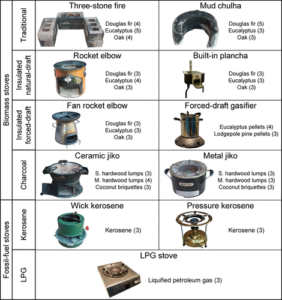Best Biomass Stoves in the Indian Market
To find the best biomass stoves in the current Indian market, you can:
- Visit local appliance stores, dealers, or showrooms to see and test available options.
- Read online reviews and consult user feedback to learn about the experiences of other consumers with specific stove models.
- Seek recommendations from friends, family, or local experts who have experience with biomass stoves.
- Contact local non-governmental organizations (NGOs) or government agencies that promote clean cooking solutions for guidance and information.
Biomass Wooden Stove with Fan
- Easy to use
- Portable biomass wooden stove
- Need a fan at the bottom
- Carbon Steel oven (Chul Shegadi) for wood and Coal Stove
- It is useful for cooking Stoves Indoor or Outdoor
Stoves for Outdoor Cooking
- Lineslife Camping Rocket Stove
- Wood Burning Portable for Cooking, Outdoor Camping
- Wood Stove with Carry Bag for Backpacking Emergency RV Survival
- Versatility of Fuel
- Black Two Doors
- This stove is more efficient but it is more expensive compared to other biomass stoves
Biomass Gasification Stoves with Fan
- this is a revolutionized Biomass stove for Smokeless Cooking Stoves or Chulha
- The type of fuel used for these stoves: Wood, Paper Waste, Burning Backpacking stove Biowaste in the Home
- This metal stove is 90% Smokeless,
- Low time for cooking 60% and save around 50% wood
- This stove has a unique Design, Efficient Burning:
- The wood stove has a double wall and a Fan at the bottom to flow cold air
- improved burning efficiency
Best Charcoal Stoves
- Charcoal Foldable Barbeque Grill
- Anti-Rust, Anti-Deformation, and Scratch Resistant
- Perfect for Grilling Burgers
- Vegetables, Steaks & Hot Dogs
Portable Outdoor Cooking Stove
- Wood Burning Stove
- Ultralight Camping Wood Stove
- Heat Resistant for Hiking Picnic Traveling
- High thermal efficiency
- Ash removal base
How to Select the Best Biomass Stoves
- Selecting the best biomass stove on the market involves considering various factors to ensure it meets your specific needs and preferences.
- Biomass stoves are a sustainable and efficient way to cook, heat, and generate energy using organic materials like wood, pellets, or agricultural residues.
- You can evaluate the performance of biomass stoves as given parameters in the post. You can get some reviews to select the best stoves.
- Each biomass stove has advantages and disadvantages as mentioned the the post.
- Here are some steps to help you choose the best biomass stove:
Determine Your Purpose:
- Decide whether you want a biomass stove for cooking, heating, or electricity generation.
- Your specific needs will influence the type and size of stove you should choose.

Fuel Type:
- Biomass stoves can burn various types of fuel, including wood, wood pellets, corn, agricultural waste, and more.
- Choose a stove that can use a readily available and sustainable fuel source in your area.
- For biomass pellet stoves you can visit the post on this website.
Size and Capacity:
- Consider the size of the stove and its heating or cooking capacity.
- Ensure it can accommodate the amount of food you need to cook or heat the space effectively.

Efficiency:
- Look for stoves with high-efficiency ratings. Efficiency determines how well the stove converts fuel into heat or electricity.
- The higher the efficiency, the more cost-effective and eco-friendly the stove. You can use instead of tandoor stoves of large size to reduce heat losses due to the overburning of wooden pieces.
Emissions:
- Check the stove’s emission levels, especially if you’re concerned about air quality.
- Low-emission stoves are better for the environment and your health.
- Try to understand emissions formed the biomass stoves and controls
Certification:
- Look for stoves that are certified by reputable organizations like the Environmental Protection Agency (EPA).
- Certification ensures that the stove meets specific environmental and safety standards.
Installation and Ventilation:
- Consider the installation requirements and ventilation needs of the stove.
- Some stoves require a chimney or venting system, while others can be used indoors with minimal ventilation.
Cost:
- Set a budget and compare prices. Remember that the upfront cost is just one factor; also consider the long-term operating costs, including fuel expenses.
Brand and Reviews:
- Research the brands and models available in the market.
- Read reviews and seek recommendations from other users to learn about their experiences with the stove.
Maintenance and Durability:
- Find out about the maintenance requirements of the stove.
- Stoves with simple maintenance routines are usually more convenient. Consider the stove’s durability, as a longer lifespan can save you money in the long run.
Features:
- Some biomass stoves come with additional features such as timers, programmable settings, or Wi-Fi connectivity.
- Evaluate whether these features are important to you.
Local Regulations:
- Check local regulations and building codes to ensure your chosen stove complies with any restrictions or requirements in your area.
Energy Efficiency Incentives:
- Look into any government incentives or rebates for using energy-efficient biomass stoves.
- These can help offset the initial cost. Calculate the efficiency of biomass stoves for cooking in the post.
Consult an Expert:
- If you’re unsure about which stove to choose, consider consulting with a professional installer or expert in biomass stoves to get personalized advice.
Summary
- The best biomass stove for you will depend on your specific needs and circumstances.
- Take your time to research and compare options to make an informed decision that suits your cooking, heating, or energy generation requirements while also aligning with your environmental goals.
